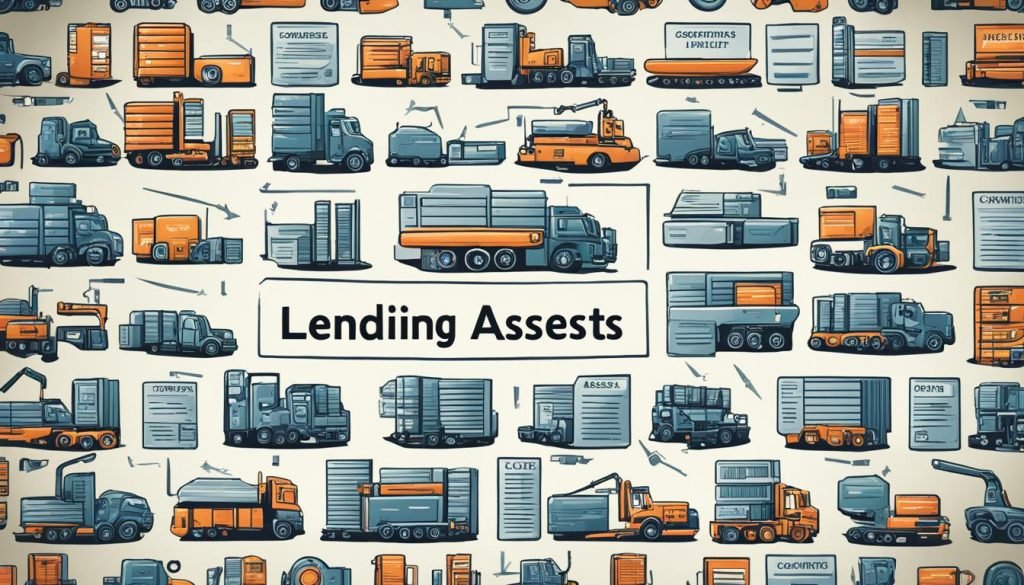
Asset-based lending (ABL) is a smart way for companies to use their assets to grow. It’s different from other loans because it looks at your assets like your balance sheet, and how much they’re worth as a guarantee. This makes it easier to borrow more money than you might with a classic loan that’s focused only on your cash flow.
It works great for businesses that don’t always make a lot of money each year. By putting up assets like what’s owed to you, what you have in stock, your machines, or even buildings as security, you can get cash to work with. This can help your business grow or just make your everyday money situation better.
Key Takeaways:
- Asset-based lending enables businesses to leverage their assets for growth.
- ABL focuses on the value of assets as collateral, providing a predictable debt capacity.
- Thin or volatile EBITDA margins are ideal for asset-based lending.
- Receivables, inventory, equipment, and real estate can be used as collateral.
- Asset-based lending helps businesses access working capital and fuel growth.
How Asset-Based Lending Works
Asset-based lending uses a company’s assets as loan collateral. It lets businesses get money they need by putting their assets to work. With this method, the loan amount depends on the asset’s value, ensuring a safe way to borrow.
The collateral is vital in this lending. Lenders check the value of things like what’s owed to you, items on hand, tools, or property to set a borrowing base. This base is the most money a lender will offer. They normally give a share of what assets are worth, like 85% from what’s owed and 50% on items in stock.
You can get this loan as a one-time amount or as money you can borrow and pay back over and over. The money from these loans can help your business grow, buy equipment, or manage daily expenses.
The rules for these loans are like those for regular business loans. How often you report your assets, the interest you pay, and when you have to pay it back are set in the loan agreement.
This type of lending is good because it lets businesses borrow using what they already own as a guarantee. It’s a great way to get the money needed to grow, even when cash on hand is low.
Benefits of Asset-Based Lending
Asset-based lending helps businesses manage their cash flow better. This finance type lets companies use the value hidden in their assets. They can use things like receivables, inventory, or real estate to get quick cash. This money can then be used for growing the business or handling costs.
This type of lending is more flexible than traditional loans. Traditional loans mostly look at the money a company makes to decide how much to lend. Asset-based loans look at the value of the business’s assets. This means more money might be available. It helps businesses fund big projects or emergencies easier.
Also, these loans usually come with good interest rates. They are cheaper because the assets secure the money. Lenders feel safer and offer better deals. This means less cost for businesses to get the money they need.
Besides, it opens doors for businesses with little credit or startups. Getting traditional loans is hard without good credit and a long history. Asset-based lending looks at what a business owns. This makes it easier for a wide range of businesses to borrow.
Asset-based lending is a great way for businesses to better use their money. It allows for smarter cash flow handling and more financial freedom. With good rates and less strict rules, it’s an attractive choice for many companies.
Types of Assets Used in Asset-Based Lending
Asset-based lending is a way for businesses to get money by putting up assets. These might include invoices, inventory, equipment, or even real estate. Let’s look at each type and how they work.
1. Receivables
Receivables are outstanding invoices a business is waiting to be paid. With asset-based lending, businesses can use these invoices to get a loan. It helps when they need quick cash for operations or to grow.
2. Inventory
Businesses can also use their unsold products as collateral. By doing this, they can get a loan. This loan can help with buying more inventory or expanding their product lines.
3. Equipment
Equipment, like office machines or big tools, can be valuable for loans. If a business owns equipment, they can get money based on its value. This money is often used for buying new equipment or making sure the existing ones work well.
4. Real Estate
Lastly, businesses with commercial property can use that property to get a loan. This loan could be used to make the business bigger or better.
These assets can help businesses get the cash they need. It’s like unlocking the value of the business to support its growth.

Now that we know about the assets, we’ll look at how important it is to know the value of these assets. This is key in asset-based lending.
Asset Valuation in Asset-Based Lending
In asset-based lending, asset values are key. They decide how much money lenders will give. Lenders use appraisals to value assets. They look at the market value, condition, and how easily the asset can turn to cash.
Assets like receivables, which are easy to turn into cash, are worth more. They let businesses borrow more. But, things like specialized equipment aren’t as favorable. They might get lower values from lenders.
For businesses wanting loans backed by assets, knowing how assets are valued is crucial. This knowledge helps them understand their borrowing power. They can then use this to make smart choices about their assets.
“Asset valuation is a key part of asset-based lending. Lenders look at asset liquidity and market value to set the borrowing base. Knowing how lenders value assets helps businesses get more loans.”
Factors Affecting Asset Valuation:
- Market value of the asset
- Condition and quality of the asset
- Liquid assets
- Sales and market trends
By checking these points, lenders set a fair value for assets as loan collateral.
Asset Liquidity:
The term “liquidity” looks at how fast an asset can become cash without losing its value. Asset type’s liquidity affects its value. Receivables are good examples; they change to cash easily, so lenders think of them highly.
Let’s see how different assets rank in liquidity:
| Asset Type | Liquidity Level |
|---|---|
| Receivables | High |
| Inventory | Moderate |
| Equipment | Low |
| Real Estate | Low |
Getting what makes an asset liquid helps businesses pick the best collateral. This way, businesses can increase their loan options in asset-based lending.
Risks and Considerations in Asset-Based Lending
Asset-based lending has its benefits, but knowing the risks is crucial. Businesses can then make smart choices and handle their finance better. This insight helps them make better financial plans.
Asset Depreciation:
Assets can lose value over time, and this is a risk. It’s key to check if the assets used as collateral will keep their value. This way, they can still be valuable throughout the loan.
Operational Oversight:
Asset-based loans need more checking and reporting than normal loans. Lenders might want updates on the asset’s condition and how they’re doing. This adds more work for the borrower. Having good controls and systems in place is important to handle these demands.
Costs and Fees:
Remember, asset-based loans come with their own set of costs and fees. These include appraisal and legal fees, and sometimes, the interest may be higher. Knowing the full cost is critical for deciding if these loans are right for your business.
Liquidity Risk:
There’s also the liquidity risk when it comes to paying back the loan. If a business can’t pay, the lender can sell the asset. But, if the selling price doesn’t cover the debt, the business may lose money.
“Asset-based lending offers businesses unique financing opportunities, but it’s important to carefully evaluate the potential risks and considerations. By understanding these factors upfront, businesses can effectively manage their assets, optimize loan terms, and mitigate potential challenges.”
Knowing about the risks of asset-based lending helps businesses choose wisely. Doing your homework, checking asset values, and understanding costs is vital. This way, businesses can use this type of funding to grow and succeed.
Navigating the Asset-Based Lending Process
Successfully getting through the asset-based lending process means getting your documents in order. You must have your financial papers, lists of assets, legal papers, and a strong business plan ready. Understanding the loan terms before you sign is also crucial.
Knowing about the loan’s borrowing limit, rules, fees, and what happens if you can’t pay is very important.
Getting to know the process and what you need to do is important. This makes you feel more secure when talking to lenders about getting a loan. Remember a few key points:
- Get all your financial papers ready. Lenders look at things like balance sheets and income statements to see if you can pay the loan back.
- Make a detailed list of your assets. Write down exactly what you have and how much it’s worth to use as loan security.
- Collect your legal papers. These can be things like your business’s registration and tax info. They prove your business is legal and responsible.
- Have a good business plan. Your plan should show how your business will make money and how you plan to use the loan.
- Know the loan’s rules well. Understand how the loan is calculated, what you must do, and how much it will cost you. This helps you decide if the loan is good for your business.
By taking these steps, you’ll be ready for the asset-based loan process. This will help you get closer to securing the financial help your business needs.
Conclusion
Asset-based lending is a great way for companies to grow. They can use their things as a guarantee to get money. This money helps them operate better and grow quicker. Unlike normal loans, asset-based lending offers more money, flexible terms, and good rates.
But, there are risks to think about. Things could lose value, and more managing is needed. Companies should know how this lending works and have their papers ready. This includes their financials and a strong business plan.
Understanding asset-based lending and getting ready can help companies a lot. They can use this financing well and grow in a healthy way.
FAQ
What is asset-based lending?
How does asset-based lending work?
What are the benefits of asset-based lending?
What types of assets are used in asset-based lending?
How is asset valuation determined in asset-based lending?
What are the risks and considerations in asset-based lending?
How do I navigate the asset-based lending process?
Is asset-based lending a good financing option for business growth?
Source Links
- https://firstbusiness.bank/business-banking-services/specialty-finance-services/asset-based-lending/
- https://www.usbank.com/financialiq/plan-your-growth/loans/can-ABL-options-fuel-your-business-and-keep-it-running.html
- https://www.linkedin.com/pulse/asset-based-lending-businesses-comprehensive-guide-greg-didonna-w871c




22 replies on “Asset-Based Lending: Leveraging Your Business Assets for Growth”
I don’t think the title of your article matches the content lol. Just kidding, mainly because I had some doubts after reading the article.
Your article helped me a lot, is there any more related content? Thanks!
Thank you for your sharing. I am worried that I lack creative ideas. It is your article that makes me full of hope. Thank you. But, I have a question, can you help me?
Thank you for your sharing. I am worried that I lack creative ideas. It is your article that makes me full of hope. Thank you. But, I have a question, can you help me? https://accounts.binance.com/ES_la/register?ref=T7KCZASX
Thank you for your sharing. I am worried that I lack creative ideas. It is your article that makes me full of hope. Thank you. But, I have a question, can you help me?
An impressive share, I just given this onto a colleague who was doing a little analysis on this. And he in fact bought me breakfast because I found it for him.. smile. So let me reword that: Thnx for the treat! But yeah Thnkx for spending the time to discuss this, I feel strongly about it and love reading more on this topic. If possible, as you become expertise, would you mind updating your blog with more details? It is highly helpful for me. Big thumb up for this blog post!
Can you be more specific about the content of your article? After reading it, I still have some doubts. Hope you can help me.
Thank you for your sharing. I am worried that I lack creative ideas. It is your article that makes me full of hope. Thank you. But, I have a question, can you help me?
Thanks for sharing. I read many of your blog posts, cool, your blog is very good.
Can you be more specific about the content of your article? After reading it, I still have some doubts. Hope you can help me.
Do you have a spam problem on this website; I also am
a blogger, and I was wondering your situation; many of us
have developed some nice procedures and we are looking to exchange solutions with other folks, please shoot me an email
if interested.
Also visit my blog post: youtube video downloader mp3
Thanks for sharing. I read many of your blog posts, cool, your blog is very good.
Thank you for your sharing. I am worried that I lack creative ideas. It is your article that makes me full of hope. Thank you. But, I have a question, can you help me?
Can you be more specific about the content of your article? After reading it, I still have some doubts. Hope you can help me. https://accounts.binance.info/en-IN/register?ref=UM6SMJM3
Can you be more specific about the content of your article? After reading it, I still have some doubts. Hope you can help me. https://www.binance.info/zh-CN/register?ref=VDVEQ78S
Thanks for sharing. I read many of your blog posts, cool, your blog is very good.
Thanks for sharing. I read many of your blog posts, cool, your blog is very good.
Very wonderful information can be found on weblog. “Time discovers truth.” by Lucius Annaeus Seneca.
I don’t think the title of your article matches the content lol. Just kidding, mainly because I had some doubts after reading the article.
I have been reading out some of your stories and i must say pretty nice stuff. I will surely bookmark your website.
Your point of view caught my eye and was very interesting. Thanks. I have a question for you.
I’ve learn some just right stuff here. Certainly worth bookmarking for revisiting. I surprise how a lot effort you put to make this type of wonderful informative web site.